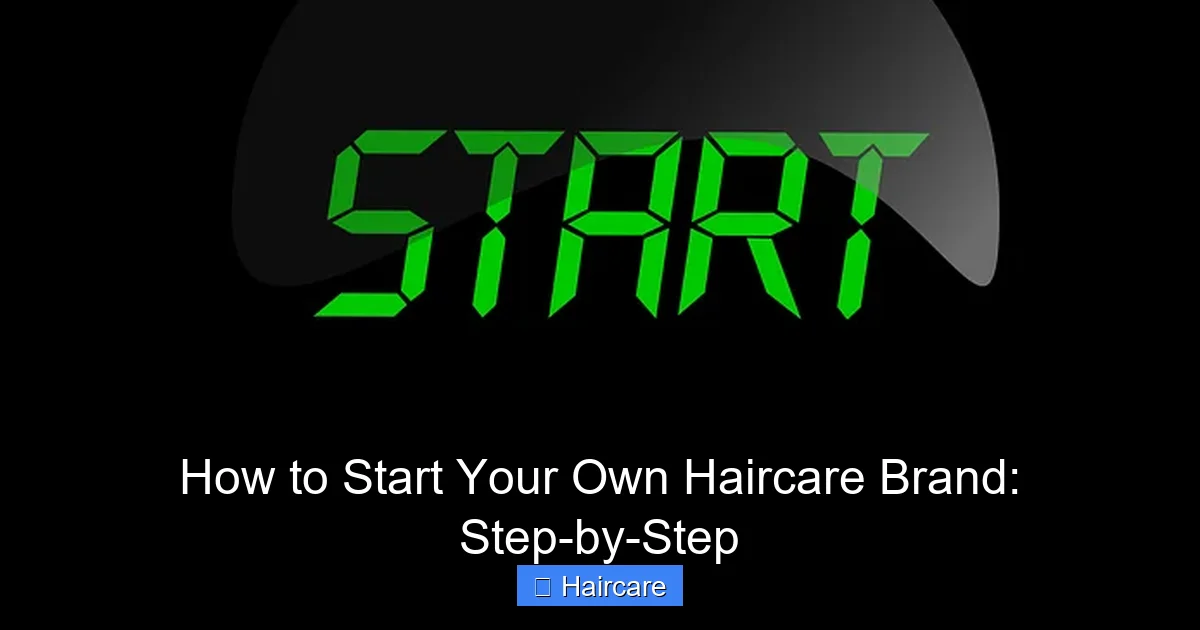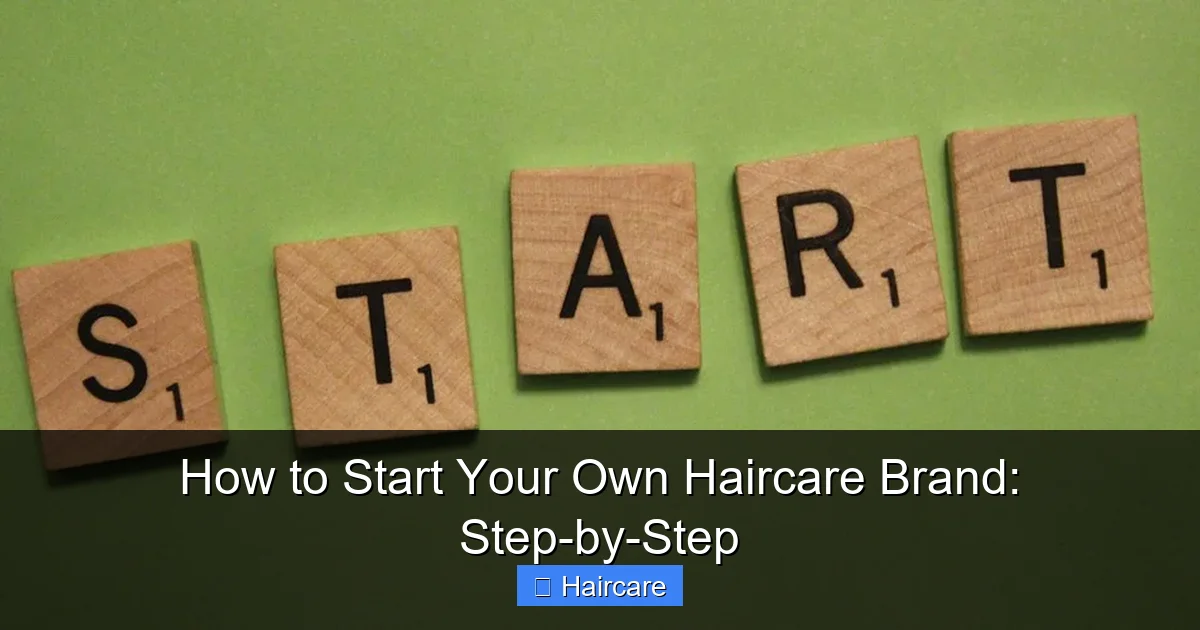
Featured image for this comprehensive guide about how to start a haircare brand
Image source: cdn.pixabay.com
Have you ever dreamed of seeing your unique vision transform into a beloved product line? The beauty industry, particularly the haircare sector, is a vibrant and ever-evolving space ripe with opportunity for innovators and entrepreneurs. If you’re passionate about healthy hair and have a desire to create something truly special, then learning how to start a haircare brand could be your next big adventure.
The global haircare market was valued at over $80 billion in 2023 and is projected to grow significantly, driven by increasing consumer awareness of ingredients, personalized solutions, and sustainable practices. This growth signifies a vast potential for new brands that can connect with specific needs and values. Launching your own line might seem daunting, but with a strategic approach, passion, and the right guidance, you can turn your dream into a thriving reality. This comprehensive guide will walk you through every essential step to start your own haircare brand.
📋 Table of Contents
Define Your Vision and Niche
Before diving into formulations and marketing, the very first step in starting a haircare brand is to clearly define your vision and pinpoint your niche. The market is crowded, so uniqueness is key.
Identifying Your Target Audience
Who are you trying to reach? Are they individuals with curly hair, oily scalps, color-treated hair, or those seeking anti-aging solutions? Perhaps you’re targeting a demographic interested in natural, organic, or vegan products. Understanding your ideal customer’s needs, concerns, and values will inform every decision you make.
| Startup Phase | Key Activities & Considerations | Estimated Resources (Time & Cost) |
|---|---|---|
| Market Research & Niche | Identify target audience (e.g., curly hair, oily scalp), analyze competitors, define unique selling proposition (USP). The global haircare market is projected to reach $107.5 billion by 2027. | 1-2 Months, $500 – $2,000 (for reports/tools) |
| Product Formulation & Sourcing | Develop unique formulas, source ingredients, work with formulators or contract manufacturers. Focus on safety, efficacy, and desired claims (e.g., natural, vegan). | 3-6 Months, $5,000 – $20,000+ (R&D, samples per SKU) |
| Branding & Packaging Design | Create brand identity, logo, visual assets, and design appealing, functional packaging. Consider sustainable materials, which can impact costs. | 1-3 Months, $2,000 – $10,000+ (for professional design) |
| Legal & Regulatory Compliance | Business registration, trademarking, adherence to FDA (US) or EU cosmetic regulations, product safety testing, liability insurance. | Ongoing, $1,000 – $3,000 (initial setup & fees) |
| Initial Production & Inventory | Select a manufacturer, place initial order, meet Minimum Order Quantities (MOQs), establish quality control. MOQs often range from 500-2,000 units per product. | 2-4 Months, $5,000 – $30,000+ (for initial inventory) |
| E-commerce & Marketing Launch | Build an online store (DTC focus), develop content strategy, initiate social media campaigns, influencer outreach, and launch promotions. | 1-2 Months (platform setup), $2,000 – $10,000+ (initial marketing) |
- Demographics: Age, gender, income level, location.
- Psychographics: Lifestyle, values, interests, pain points, purchasing habits.
Researching Market Gaps
A deep dive into market research is crucial. What are existing brands doing well, and where are they falling short? Look for underserved segments or unmet demands. Is there a need for more sustainable packaging, cleaner ingredients, or highly specialized treatments that aren’t readily available? Identifying these gaps will help you carve out a distinct space for your haircare brand.
Consider:
- What specific hair concerns are not adequately addressed by current products?
- Are there cultural or demographic groups whose hair care needs are overlooked?
- Can you offer a superior product, a unique ingredient story, or a more compelling brand experience?
Product Development and Formulation
This is where your vision truly takes shape. The quality and efficacy of your products will be the backbone of your haircare brand‘s success.

Learn more about how to start a haircare brand – How to Start Your Own Haircare Brand: Step-by-Step
Image source: live.staticflickr.com
Sourcing Ingredients and Suppliers
Whether you’re developing custom formulas or using a private label, understanding your ingredients is paramount. Research reputable suppliers for raw materials, ensuring they meet quality standards and align with your brand’s ethos (e.g., organic, fair trade, cruelty-free). Ingredient transparency is increasingly important to consumers.
Private Label vs. Custom Formulation
You have two primary paths for creating your products:
- Private Label: This involves choosing pre-existing formulas from a manufacturer and customizing them with your branding. It’s often quicker, less expensive, and ideal for beginners to start a haircare brand with lower risk.
- Custom Formulation: This means working with a cosmetic chemist to create unique formulas from scratch. While more expensive and time-consuming, it allows for complete control over ingredients, performance, and uniqueness, setting your haircare brand apart in the long run.
Regardless of the path, rigorous testing for stability, efficacy, and safety (e.g., patch testing) is non-negotiable.
Branding, Packaging, and Identity
Your brand identity is more than just a logo; it’s the personality and promise of your haircare brand. It’s how consumers perceive you.

Learn more about how to start a haircare brand – How to Start Your Own Haircare Brand: Step-by-Step
Image source: s3-us-west-2.amazonaws.com
Crafting Your Brand Story
What’s the narrative behind your brand? Why did you start it? What values do you uphold? A compelling brand story creates an emotional connection with your audience and differentiates you beyond just the product. Share your mission, your passion, and what makes your haircare brand authentic.
Designing Impactful Packaging
Packaging is often a consumer’s first physical interaction with your product. It needs to be visually appealing, functional, and reflective of your brand’s values. Consider:
- Aesthetics: Colors, fonts, imagery that align with your brand identity.
- Functionality: Ease of use, appropriate size, durability.
- Sustainability: Recyclable materials, post-consumer recycled (PCR) plastic, refillable options are highly valued by today’s eco-conscious consumers.
- Information: Clear ingredient lists, usage instructions, and regulatory compliance details.
Invest in professional graphic design to ensure your branding and packaging make a strong first impression.
Legalities, Compliance, and Manufacturing
Navigating the legal landscape is a critical, albeit less glamorous, step to start a haircare brand successfully and responsibly.
Business Registration and Intellectual Property
Formalize your business by choosing a legal structure (sole proprietorship, LLC, etc.) and registering your business name. Crucially, protect your brand identity by trademarking your brand name, logo, and any unique product names. This prevents others from using your intellectual property.
Understanding Industry Regulations
The cosmetics industry is regulated to ensure product safety. In the United States, the FDA oversees cosmetics, requiring proper labeling and adherence to Good Manufacturing Practices (GMP). In Europe, the EU Cosmetics Regulation is stricter, requiring a Product Information File (PIF) and safety assessments. Consult with regulatory experts to ensure your products meet all necessary guidelines in your target markets.
Choosing a Manufacturer
Selecting the right manufacturing partner is vital. Look for a manufacturer that:
- Has experience with haircare products.
- Adheres to GMP standards.
- Offers quality control and testing services.
- Can scale production as your brand grows.
- Communicates transparently and reliably.
Establish clear contracts outlining production schedules, quality standards, and intellectual property rights.
Marketing, Sales, and Distribution Strategy
Once your products are ready, it’s time to get them into the hands of your eager customers. A robust marketing and sales strategy is essential for any aspiring haircare brand.
Building an Online Presence
In today’s digital age, an engaging online presence is non-negotiable. Develop a professional e-commerce website that is user-friendly, mobile-responsive, and visually appealing. Leverage social media platforms (Instagram, TikTok, YouTube, Pinterest) to tell your brand story, showcase your products, and engage with your target audience. Consider creating valuable content like hair care tips, tutorials, and behind-the-scenes glimpses to build a community around your haircare brand.
Launching Your Products
A successful launch requires careful planning. This might include:
- Influencer Marketing: Collaborating with hair and beauty influencers to generate buzz and reach their followers.
- Press & PR: Sending press kits to beauty editors and publications.
- Launch Promotions: Offering introductory discounts or bundles.
- Email Marketing: Building an email list pre-launch and sending exclusive updates.
Scaling Your Brand
As your haircare brand gains traction, consider expanding your distribution channels. This could include:
- Wholesale: Selling to salons, boutiques, or larger retailers.
- Marketplaces: Listing your products on platforms like Amazon or Sephora.
- International Expansion: Exploring new markets once you’ve established a strong domestic presence.
Continuously gather customer feedback to refine your products and marketing efforts.
Launching a haircare brand is an exciting journey that combines creativity with business acumen. By meticulously following these steps — from defining your niche and developing exceptional products to building a powerful brand and navigating legalities — you’ll be well-equipped to transform your passion into a successful enterprise. The path may have its challenges, but with dedication and a genuine love for hair care, your brand can truly flourish and make a lasting impact on the beauty world. Are you ready to take the leap and start your own haircare brand?
Frequently Asked Questions
What’s the very first step to start a haircare brand?
Begin by identifying your niche and target audience. Research market gaps and understand what specific hair concerns or demographics your haircare brand will uniquely address. This foundational step helps define your product line and overall brand identity.
How do I create unique products for my haircare brand?
You can either develop formulations yourself with cosmetic chemists, use private label manufacturers, or white-label existing products. Focus on ingredients and benefits that align with your brand’s unique selling proposition to ensure product distinction and effectiveness.
What legal considerations are there when starting a haircare brand?
Key steps include registering your business, trademarking your brand name and logo, and ensuring all product labels comply with cosmetic regulations like FDA guidelines. You’ll also need product liability insurance for protection against potential claims.
How much capital is typically required to start a haircare brand?
Startup costs vary significantly based on your production method, marketing budget, and initial inventory size. Create a detailed business plan to estimate expenses for formulation, manufacturing, branding, and distribution to get a realistic figure.
What are effective ways to market my new haircare brand?
Focus on digital marketing, including social media, influencer collaborations, and content marketing demonstrating product benefits and usage. Build a strong brand story and engage with your target audience authentically to create buzz and drive sales.
How can my haircare brand stand out in a crowded market?
Develop a strong, authentic brand identity and unique selling proposition (USP) that resonates with your target audience. Emphasize sustainable practices, unique ingredient combinations, or a compelling brand story to differentiate your products effectively.
